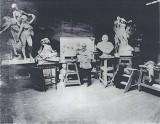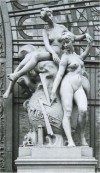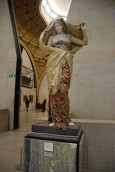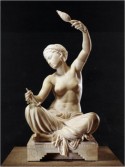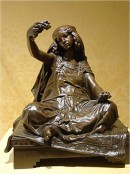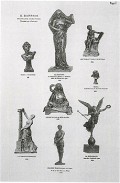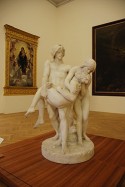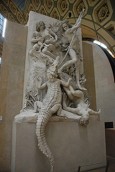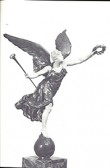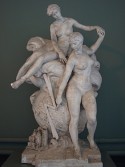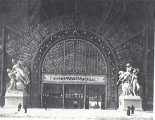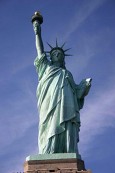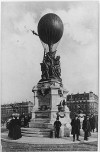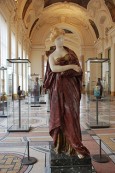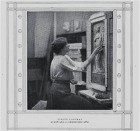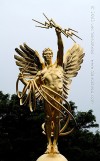The browser will either open the file, download it, or display a dialog.
In 1879, Harvard University professor Charles Eliot Norton presented a lecture at the annual convention of the American Institute of Architects on the relationship of painting and sculpture to architecture. To this audience, he noted that all art must arouse the modern spirit:
In our times the artist will do well to avoid allegory; it is ill adapted to our prevailing temper and to modern modes of thought. It is not the form in which the poetic sentiment in these days inclines to embody itself. Modern allegories leave the reader or the beholder unmoved, and the public service of art may well be called into question if the artist chooses a mode of expression remote from the common understanding, and incapable of touching the emotions with direct and forcible appeal.[1]
Norton was not alone in his sentiments about the use of allegory in modern art; in fact his is only one of many treatises against its use published in the latter half of the nineteenth century. Prior to the nineteenth century, allegory, or the combination of personifications with intellectual concepts, had long been used in the history of Western art as a device to make abstract ideas tangible. From the ancient Greeks, who used it to disseminate ideas about the human condition, to the writings of Johann-Joachim Winkelmann (1717–68), who in his Versuch Einer Allegorie (1766) supported their adoption by contemporary artists, allegories remained an important means for visual artists to illustrate ideas. Allegory almost always requires the human body as the site of meaning for universal truths and thus served well those visual artists, viewers, and collectors excessively interested in the human form. Yet it has been argued that the use of allegory fell out of favor during the nineteenth century for its lack of directness and its overly-classicized symbolism. While some of the most important paintings in the early years of the century relied on allegorical symbolism, use of the form waned in that medium. As the title of Gustave Courbet’s The Painter’s Studio, A Real Allegory of Seven Years of My Life as a Painter (1855) suggests, to be useful, allegories had to make reference to real experience and to the modern world. Yet, at the same time, the interest in retaining links to classical allegorical forms lingered in the fine arts throughout the remainder of the century. This link to classical art forms continued in sculpture particularly because sculpture remained largely figurative until well into the second decade of the twentieth century, and both the male and female body functioned as symbols for various intangible concepts. Study of contemporary foundry catalogues shows that allegories continued to be produced for sale, and that “allegory for allegory’s sake” as noted by Peter Fusco, continued in the form of the statuette.[2] While classical allegories such as Abundance, Earth, Fortitude, Justice, and Opportunity may have begun their decline in significance in art, one finds that new allegorical forms, particularly those that represented innovative technologies and scientific advances (for example, Electricity, Steam, and Light), were beginning to gain prominence, particularly in the medium of sculpture. Informed by the Industrial Revolution, allegories could be modern and could be kept viable if an artist could apply them directly to modern advancement, progress, and experience. This was not without its difficulties, because artists had to invent the symbolism to glorify modernity through a traditional, somewhat old-fashioned visual vocabulary.
In this brief article, I hope to initiate a discourse around the topic of the rise of the “modern allegory," using the sculpture of Louis-Ernest Barrias (1841–1905) as a starting point (fig. 1). Barrias's oeuvre included many sculptures dedicated to Modernity, specifically to the promotion and glorification of new technologies advanced by nature, and the social conditions of daily life. In his Allegory of Electricity (1889; fig. 2) and Nature Unveiling Herself before Science (1899; fig. 3) Barrias successfully used allegory to connect natural forces to modern progress, and arguably influenced the later Art Deco style in France and America, which often similarly promoted a technological utopia. As Alberto Shayo has observed, “the period immediately following World War I is sometimes described as a second industrial revolution, one in which the use of the machine transformed not only society’s structure, but every aspect of people’s daily lives.”[3] Whether or not Barrias completely succeeded in ushering allegorical forms into the twentieth century, his efforts in this endeavor should not be disregarded.
Barrias, unquestionably one of the most successful and prolific sculptors of his generation, was academically trained at the Ecole des Beaux-Arts and was awarded the Prix de Rome in 1864. His biographer, Georges Lafenestre, listed over 216 works in his oeuvre, which included sculptural groups, funerary sculptures and memorials, relief sculptures, busts, medallions, and plaques.[4] Barrias did not create only allegorical-themed sculptures; his more famous pieces included his Orientalist-themed sculptures Spinner of Megara (1870; fig. 4) and Young Girl from Bou-Saâda (1890–94; fig. 5), which were reproduced by the Susse Frères Foundry in various sizes (fig. 6).[5] His subjects were wide-ranging, and included emotional religious themes, from the pathos-laden Biblical theme The First Funeral of 1878 (fig. 7), to themes of stark violence, as in his Alligator Hunters of 1893 (fig. 8). While Barrias produced many emotive sculptural concepts such as these, he had a strong interest in creating allegorical works, as can be seen in several of his public monuments such as his La Défense de Paris (1883; fig. 9), a commission for which his maquette was chosen over those of a number of his important peers, including Auguste Rodin.[6] Barrias was well-versed in allegorical iconography from ancient and Renaissance examples; his Allegory of Fame (1893–1902; fig. 10), originally conceived as part of his now-destroyed monument to Victor Hugo, includes the winged female messenger, trumpet, and laurel crown often found in representations of this allegory.[7] An earlier group entitled Allegory of Charity (1874, fig. 11) shows a female figure surrounded by children, one attempting to feed from the figure’s breast, a common iconographic element for depictions of Charity. Due to his popularity at the Salon exhibitions in Paris, there was probably not a better artist in France than Barrias to try to advance the use of allegory in modern sculpture. Regardless of his many professional successes, public commissions, memberships, and presence at thirty-one Salon exhibitions from 1863 through 1902, Barrias, like many sculptors of his generation and academic training, was affected by the decline in taste for academic art, which had become associated with L’art pompier.[8]
Barrias did find significant success, however, with his Allegory of Electricity (fig. 12). While the exhibition version ofthe sculpturewas destroyed after the closing of the 1889 Universal Exhibition, another plaster survives at the Ny Carlsberg Glyptotek in Copenhagen, where there is a Barrias room with examples of his most well-known works.[9] Filled with the collections of the museum’s founder Carl Jacobsen, galleries were created within his museum for examples of contemporary French sculpture, including works by Paul Dubois, Alexandre Falguière, Constantin Meunier, Rodin, and Barrias.[10] These were some of the most significant French sculptors of the 1880s and 1890s, whose works populated the Paris Salon exhibitions of those years, and whose sculptures Jacobsen particularly admired. While the Ny Carlsberg Glyptotek did not open to the public until 1897, Jacobsen had approached Barrias two years earlier to buy existing examples of his work and to commission new ones for the proposed room in his honor.[11] The artist had already finished his Allegory of Electricity for the Universal Exposition of 1889, and Jacobsen, having seen the original plaster for it in Barrias’s studio, asked the artist to produce a marble version for him for the Barrias room. The marble was never produced, but Jacobsen did eventually acquire the plaster in addition to twelve other works by the artist.[12]
Barrias received the commission for the Allegory of Electricity with a fee of 25,000 francs, a sizable sum for the period.[13] The final exposition version was colossal at thirty feet high and brazen with its unidealized, ample nudes whose delicate touch of a lightning bolt and each other symbolically create an electrical circuit. The sculpture is balanced at the bottom left with accoutrements that make the generating of natural electricity possible. It was shown as a companion to another allegory, Steam (1889), by Henri Chapu (1833–91). Originally Chapu was commissioned to make Electricity and Barrias to make Steam.[14] Symbolizing two natural forces that contribute to making the running of machines possible, Electricity and Steam flanked the entrance to the Palais des Machines at the Universal Exposition of 1889, which was a veritable temple to modern technology (fig. 13). In the 1980 exhibition catalogue Romantics to Rodin: French Nineteenth-Century Sculpture from North American Collections, Marie Busco and Peter Fusco, in writing about a maquette for Electricity, explained what they felt was this sculpture's modern and confusing symbolism: “Electricity was intended as an hommage to the modern world—to the spirit of invention, progress, science and technology. . . . For his work Barrias juxtaposed traditional allegorical devices, such as the voluptuous female nudes and the signs of the zodiac, with a realistically rendered engine in an uncomfortable union of the old and the new.”[15]
Undoubtedly, producing a monumental sculpture with the goal of elevating modern technology was not easy. Nonetheless, the use of traditional allegorical vocabulary, which the visually literate would have associated with noble concepts, may have made it possible for contemporaries to comprehend the glorification of the technology of their own times. Sculptor Jules Salmson, writing about his métier in 1892, noted that “allegory … will remain the eternal resource of monumental art for translating, by condensing them, the grand thoughts worthy of characterizing a century, its aspirations, progress, beliefs and its particular genius.”[16]
The creation and presentation of Electricity as an allegory also permitted its highly sensual nudity to be accepted by a society which otherwise might not allow such overt sexuality in public art. Only twenty years earlier, the allegorical group known as The Dance by Jean-Baptiste Carpeaux (1827–75) suffered ridicule and had a bottle of ink thrown at it because it was seen as an overt display of public sexuality; Carpeaux’s work lacked “readable” allegorical symbolism.[17] Fusco has noted that by mid-century, any nude or partially draped figure could act as an allegory for almost anything, thus weakening the allegorical method and making it less about elevating noble inventions and concepts and more about having an excuse to depict nudity.[18]
Artworks dedicated to the newly harnessed energy of electricity were important to the promotion of Modernity, particularly in reference to electric light. According to Shelley Wood Cordulack, Parisians were particularly proud of their early contributions in the area of electric lighting, which was increasingly being used in theatres, cafés, and other performance spaces throughout Paris in the 1880s and 1890s.[19] Thomas Alva Edison demonstrated his incandescent light bulb at the International Exposition of Electricity in Paris in 1881,[20] and a report by the United States commissioners of the 1889 Universal Exposition noted that although Parisians wanted electricity to be even more available, gas lighting had a near monopoly. Cordulack reveals the competition between France and America in the field of electricity, and that the influence of electric light in both countries was significant.[21] Paris was, after all, the City of Light even before electric lighting came into being (when it referred to the city as a center for Enlightenment thinkers), and the French had a vested interest in advancing that reputation. In fact, electricity was central to the theme of the 1889 exposition of science, industry and technology, and there were numerous demonstrations and discussions held about this new production.[22] Thus Barrias’s sculpture was central to the considerable debate at the very exposition at which it was exhibited.
In general, the most well-known allegorical sculptures of this era focused on advances in the technology of electricity, light, and communication. Within this context, Barrias’s contemporary Frédéric-Auguste Bartholdi (1834–1904) advanced his reputation with his allegorical colossus, Liberty Enlightening the World, found today in New York Harbor (fig. 14). The sculpture was originally planned as a lighthouse, and, the torch of the statue was electrically illuminated during its exhibition (complete with the statue’s right hand and forearm) at the Philadelphia Centennial Exhibition in 1876.[23]Liberty Enlightening the World should be understood as both a traditional allegory of liberty as well as a modern allegory of electric light. As a Freemason, Bartholdi was particularly sensitive to the symbolism of light—a key motif of that fraternal order—in his large public works.[24] His now-destroyed Monument to the Aeronauts and Pigeon Trainers of the Siege of Paris, completed posthumously in 1906, was also to be illuminated[25] and also used the traditional vocabulary of allegory—nude figures, triumphant females, winged beasts, and the like—to exalt the modern use of homing pigeons and balloon travel during the Franco-Prussian War (fig. 15).[26]
When Barrias returned to more traditional allegorical themes such as “nature” or “science,” he continued to experiment with modern techniques in his sculpture. In Mysterious and Veiled Nature Uncovers Herself before Science (fig. 16), exhibited at the Salon of 1893 and later acquired for the School of Medicine in Bordeaux, a veiled nude female reveals her body while standing firmly on a mound of grassy earth. Here, Barrias relies exclusively on the female nude to bear the heavy symbolism of nature, reflecting the revelations of natural science as discovered through scientific advancements. In his 1899 version of the sculpture, however, with the slightly modified title Nature Unveiling Herself before Science (fig. 3), the female is dressed in a flowing gown of heavy drapery, made of some of the most precious marbles and stones available. Only the breasts remain exposed, probably because this area of the female body was a traditional symbol of nature in allegorical figures from the Renaissance.
Both versions of the sculpture have been criticized for their overt sexuality. The dressed version was called a “coquette” by the contemporary critic Paul Desjardins,[27] and more recently Ludmilla Jordanova suspected that “science is a masculine viewer, who is anticipating full knowledge of nature, which is represented as the naked female body.”[28] Such readings of the works, and such criticism of Barrias as a misogynist, ignore the history of the use of allegory in sculpture and miss the point of the sculpture as an emblem of advances in science. His most striking image of a powerful natural force is seen in his Allegory of Electricity, which features two nude females harnessing power; his oeuvre included other allegories of female figures depicted as “science” and male figures as “nature”; and in the 1899 version of this work, what makes the figure an allegory of nature is not symbolized by her femaleness or her nudity, but instead by the sumptuous marbles, onyx, and precious stones used in her creation. The stones themselves are nature, and technological advancements in carving these natural materials (that were often denser than white marble) is integral to the sculpture’s message. As noted in the catalogue for the exhibition The Colour of Sculpture, held in 1996 at the Van Gogh Museum in Amsterdam and the Henry Moore Institute in Leeds, the sculpture itself is a symbol of technological advancement: “Breathtaking technical progress seemed to solve all the mysteries of the world, and it appeared only a matter of time before—to use Barrias’s visual language—nature revealed its last secrets. That such … academic female figures could still be employed at the beginning of the age of electricity is characteristic for the nineteenth-century, with its usual simultaneity of heterogeneous forms of expression.”[29] Whatever criticism may have been directed towards Nature Unveiling Herself before Science, the work was reproduced as a popular statuette, available in various media and in at least five different sizes for many years afterwards, as evidenced by the Susse Frères foundry catalogue (fig. 6).
Additionally, Debora Silverman has established that between the 1889 and 1900 Universal Exhibitions there was a change in emphasis at the expositions from technology developed through nature to pure nature itself: “In 1889 Art Nouveau welcomed a new world of public technology and the potential for a collective existence; in 1900 Art Nouveau miniaturized iron materials, recast into organic and feminine forms.”[30] One recognizes something of this shift in Barrias’s sculptures: his Allegory of Electricity emphasizes the technological role of the natural force, while Nature Unveiling Herself before Science, sculpted exactly a decade later and right before the 1900 Universal Exposition, uses the natural stones (some from quarries as far away as Algeria) [31]and the feminine form to glorify the technology used to sculpt the precious stones as well as to glorify the mysteries of nature’s eternal power.
Artistic advancements and technical prowess did not negate gender issues by any means: when the sculptor and Barrias protégé Denys Puech created his female allegory entitled Thought, a polychrome marble sculpture commissioned by the Sorbonne in 1902 (fig. 17), it was refused on the grounds that the chignon hairstyle of the figure was too modern.[32] One wonders if the hairstyle of a male figure would have made any difference. “Nature” and “Science” could be depicted interchangeably by male or female figures, as could “Electricity”; but “Thought” was usually identified as male in the nineteenth century. While rare, some contemporary sculptors explored representing “Thought” using both the male and female figure; in Rodin’s work, one finds a seated male in his well-known work, The Thinker, and a captive female in his portrait of Camille Claudel in La Pensée. In a general sense, however, a modern-looking woman was not often an acceptable stand-in for intelligence, which Barbara Gates and Ann Shteir have attributed to the “masculinization” of the field of science at the fin-de-siècle.[33] Puech’s strong reliance on Barrias’s materials (polychromy and mixed stones) and forms (allegorical female figures) in his own works nonetheless lacked the Symbolist and emotive strength found in his mentor’s works.
In the century that followed, the modern allegory as produced by Barrias and Bartholdi influenced countless American artists. Evelyn Beatrice Longman (1874–1954; fig. 18), the first female sculptor to be elected to full membership of the National Academy of Design in New York, was one of the most successful creators of grand symbols of technological progress.[34] Her Genius of Electricity (1915; fig. 19) was, after the Liberty Enlightening the World, the most recognizable sculpture in New York. Nicknamed Golden Boy, it was prominently displayed atop the Western Union Building and later became the central image of the Western Electric logo, appearing on the cover of New York telephone directories for many decades (fig. 20).[35] Longman replaced the typical female allegorical figure with a winged, nude male who tightly grips bolts of electricity. Coiled around his nude body are telephone cables, just barely covering his explicit nudity. In many ways it is more subtle and less awkward than Barrias’s Allegory of Electricity, but both use the example of classical antiquity to express the power and brilliance of the modern world. In 1889, allegory was used not only to celebrate achievement, but also to promote the products inside the Palais des Machines. Similarly in 1915, allegory glorified the corporations that commissioned such works, and the Art Deco style was a style that functioned primarily in the service of commerce.
Sculptors of the late nineteenth century and the artists who worked in the later style of Art Deco shared an interest in technological advances and modernity. In his discussion of the legacy of the fin-de-siècle, Shayo has written that, “although Art Nouveau eventually ceded its place in France to Art Deco as the style of the moment, its defining characteristics—lavish ornamentation, fine materials and superior craftsmanship—were inherited and subsequently espoused by Art Deco.”[36] One example sums up the tendency within Art Deco public sculpture to use allegorical figures to inspire people about modern progress: Lee Lawrie’s Wisdom, Sound and Light, dedicated at Rockefeller Center in New York in 1933 (fig. 21).[37] Lawrie’s polychrome limestone reliefs are a premier example of the continuation of the allegorical tradition in Modern Art. This sleek, abstract work in the heart of a complex known as Radio City celebrates the progress of radio communication. Flanked by Sound on the left and Light on the right, the figure of wisdom, shown in a traditional manner as an elderly man (and which borrows quite directly from William Blake’s The Ancient of Days from 1794), emits rays of light down upon those who enter the skyscraper. Christine Roussel has explained the specific symbolic meanings of the reliefs: “the architects chose to place the bearded sage to preside over mankind, interpret the laws of the universe, and mark the cycles of two cosmic forces: sound and light. It was within these two fields that twentieth-century man had ventured farthest in the technological and material world.”[38] The side reliefs depicting Sound and Light specifically reference the new radio and television industries of the era.[39] The allegory’s Biblical message, inscribed below the figure of Wisdom, would be one that Barrias himself would have appreciated because it seems to mirror his own aesthetic and modern concerns: “Wisdom and Knowledge shall be the stability of thy times.” Allegorical sculptures focusing on advances in the technology of electricity, light, and communication, themes so crucial to Barrias’s late work, continued to be important well into the twentieth century.
The work of sculptors in Europe and America at the turn of the century and into the early decades of the twentieth century continued to use allegory as a way of giving tangibility to modern concepts, ideas and technology. Allegorical sculptures glorified modern marvels such as the telegraph, the automobile, and radio communication. Impressive, colossal sculptures by Barrias, Bartholdi, Longman, and many others informed and inspired new generations of artists. The Art Deco style, which was popular in both France and America and celebrated the rise of commerce, industry, technology, and speed in the 1920s and 1930s, was without doubt the progeny of allegorical sculpture from the previous century.
Research funding for this article was provided by a PSC-CUNY Faculty Research Award. I graciously thank Brian Edward Hack, Joyce Polistena, and Gabriel P. Weisberg for their suggestions to the original manuscript for this article, Robert Alvin Adler for his editing skill, and the editors of Nineteenth-Century Art Worldwide for inviting me to participate in this special issue dedicated to Dr. Patricia Mainardi. Pat has been my teacher, advisor, and friend for more than twenty years. If I have produced anything of worth in my career so far, it has been largely due to Pat’s encouragement and support; I dedicate this article to her, with my deepest love and admiration.
[1] Charles Eliot Norton, “Painting and Sculpture in their Relation to Architecture,” Proceedings of the Thirteenth Annual Convention of the American Institute of Architects (New York: D. Estes and C. E. Lauriat, 1880), 46–47.
[2] Peter Fusco, “Allegorical Sculpture,” in The Romantics to Rodin, French Nineteenth-Century Sculpture from North American Collections, ed. Peter Fusco and H. W. Janson (New York and Los Angeles: George Braziller and the Los Angeles County Museum of Art, 1980), 60–69, esp. 65.
[3] Alberto Shayo, Chiparus: Master of Art Deco (New York, London and Paris: Abbeville Press, 1993), 19.
[4] Georges Lafenestre, L’Œuvre de Ernest Barrias (Paris: Philippe Renouard, 1908): 101–16.
[5] Andreas Blühm, The Colour of Sculpture, 1840-1910 (Amsterdam: Van Gogh Museum; Leeds: Henry Moore Institute; Zwolle: Waanders Uitgevers, 1996), 186.
[6] Jacques de Caso and Patricia B. Sanders, Rodin’s Sculpture: A Criical Study of the Spreckels Collection, California Palace of the Legion of Honor (San Francisco: Fine Arts Museum of San Francisco, 1977), 199, 202.
[7] Daniel Cady Eaton, A Handbook of Modern French Sculpture (New York: Dodd, Mead and Co., 1913), 242–43; and Marie Busco and Peter Fusco, “Nature Unveiling Herself Before Science,” catalogue entry in Romantics to Rodin, 120.
[8] H. W. Janson, ed. Catalogues of the Paris Salon, 1673 to 1881 (London and New York: Garland, 1977); Salons de la Société des Artistes Français, 1881-1914, Documentation Archives, Musée d’Orsay, Paris. See also H. W. Janson, “Rodin Was Not the Only One,” Portfolio, September-October 1980, 40–45, esp. 45.
[9] Anne-Birgitte Fonsmark, Emmanuelle Héran, and Sidsel Maria Søndergaard, Catalogue of French Sculpture II, Ny Carlsberg Glyptotek (Copenhagen: Ny Carlsberg Glyptotek, 1999), 24–26.
[10] Ibid., 24.
[11] Ibid., 24–26.
[12] Ibid., 25.
[13] Camille Orensanz, “La Sculpture décorative de Louis-Ernest Barrias (1841-1905),” (PhD diss. Université de Paris IV-Sorbonne, 2005–6).
[14] Henri Chapu, “Palais des Machines. – Groupe Colossal,” L’Art Français 114, June 29, 1889, 1. My research to date has not revealed why the two commissions were switched.
[15] Marie Busco and Peter Fusco, “Louis-Ernest Barrias,” in Romantics to Rodin, 116. The quote continues: “If he intended to elevate the new energy force—to endow it with a “rightness” in the cosmos—the allegory he presents is not completely intelligible. . . . As in many sculptures of the period, a seriously intended subject was treated with such a high degree of sensualism that the result was wonderfully ludicrous. Electricity demonstrates the dilemma of academic artists attempting to cope with modern technology in a traditional, outmoded vocabulary of visual expression.”
[16] Jules Salmson, Entre deux coups de ciseau, souvenirs d’un sculpteur (Paris: Lemerre, 1892), 349.
[17] Anne Middleton Wagner, Jean-Baptiste Carpeaux: Sculptor of the Second Empire (New Haven and London: Yale University Press, 1986), 230.
[18] Fusco, “Allegorical Sculpture,” 60–69, esp. 66.
[19] Shelley Wood Cordulack, “A Franco-American Battle of Beams: Electricity and the Selling of Modernity,” Journal of Design History 18, no. 2 (2005): 147–66.
[20] Ibid., 149.
[21] Ibid., 149–55.
[22] Debora L. Silverman, Art Nouveau in Fin-de-Siècle France (Berkeley: University of California Press, 1989), 3. Silverman has noted that “progress through the union of science, industry and technology was the constant theme of the planners’ 1889 reports.”
[23] Cordulack, “Franco-American Battle of Beams,” 150.
[24] Frèdèric Auguste Bartholdi, The Statue of Liberty Englightening the World (New York: North American Review, 1885), 22; see also Harry Paul Jeffers, Freemasons: A History and Exploration of the World’s Oldest Secret Society (New York: Citadel, 2005), 166.
[25] “[Bartholdi] had wanted the balloon in alabaster or glass to be illuminated at night, a possibility he had explored for the Liberty. He died shortly before the unveiling of the seven-meter bronze in 1906, at which five thousand pigeons were released as the drapery slid away.” June E. Hargrove, “The Public Monument,” in Fusco and Janson, Romantics to Rodin, 28.
[26] Sergiusz Michalski, Public Monuments: Art in Political Bondage, 1870-1997 (London: Reaktion, 1998), 54–55; and “Round About Europe,” New York Times, May 10, 1903, accessed March 5, 2012, http://query.nytimes.com/mem/archive-free/pdf?res=F00711FC385D16738DDDA90994DD405B838CF1D3 [.pdf].
[27] Paul Desjardins, “Les Salons de 1899: Sculpture,” Gazette des beaux-arts, 3rd. ser. 22 (1899): 288; Busco and Fusco, “Louis-Ernest Barrias,” 120.
[28] Ludmilla Jordanova, Sexual Visions: Images of Gender in Science and Medicine between the Eighteenth and Twentieth Centuries (Madison: University of Wisconsin Press, 1993), 87. See also Norma Broude, Impressionism, A Feminist Reading: The Gendering of Art, Science and Nature in the Nineteenth-Century (Boulder: Westview Press, 1991), 147.
[29] Blühm, Colour of Sculpture, 186.
[30] Silverman, Art Nouveau, 5.
[31] For a discussion of sculpture materials used in this period, see Philip Ward Jackson, “Sculpture Colouring and the Industries of Art in the 19th century,” in Blühm, Color of Sculpture, 73-82.
[32] Henry Jaudon, Denys Puech et son Œuvre (Paris: E. Carrère, 1908), 40, 201, 227, 242–43.
[33] Barbara T. Gates and Ann B. Shteir, Natural Eloquence: Women Reinscribe Science (Madison: University of Wisconsin Press, 1997), 9–10.
[34] Margaret Samu, “Evelyn Beatrice Longman: Establishing a Career in Public Sculpture,” Woman’s Art Journal 25, no. 2 (Autumn 2004), 8–15.
[35] Ibid., 8.
[36] Shayo, Chiparus: Master of Art Deco, 18.
[37] Christine Roussel, The Art of Rockefeller Center (New York and London: Norton, 2006), 86.
[38] Ibid.
[39] Ibid., 89.


